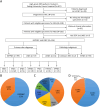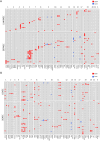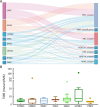Molecular features of gastroenteropancreatic neuroendocrine carcinoma: A comparative analysis with lung neuroendocrine carcinoma and digestive adenocarcinomas
- PMID: 38455367
- PMCID: PMC10915635
- DOI: 10.21147/j.issn.1000-9604.2024.01.09
Molecular features of gastroenteropancreatic neuroendocrine carcinoma: A comparative analysis with lung neuroendocrine carcinoma and digestive adenocarcinomas
Abstract
Objective: There is an ongoing debate about whether the management of gastroenteropancreatic (GEP) neuroendocrine carcinoma (NEC) should follow the guidelines of small-cell lung cancer (SCLC). We aim to identify the genetic differences of GEPNEC and its counterpart.
Methods: We recruited GEPNEC patients as the main cohort, with lung NEC and digestive adenocarcinomas as comparative cohorts. All patients undergone next-generation sequencing (NGS). Different gene alterations were compared and analyzed between GEPNEC and lung NEC (LNEC), GEPNEC and adenocarcinoma to yield the remarkable genes.
Results: We recruited 257 patients, including 99 GEPNEC, 57 LNEC, and 101 digestive adenocarcinomas. Among the mutations, KRAS, RB1, TERT, IL7R, and CTNNB1 were found to have different gene alterations between GEPNEC and LNEC samples. Specific genes for each site were revealed: gastric NEC ( TERT amplification), colorectal NEC ( KRAS mutation), and bile tract NEC ( ARID1A mutation). The gene disparities between small-cell NEC (SCNEC) and large-cell NEC (LCNEC) were KEAP1 and CDH1. Digestive adenocarcinoma was also compared with GEPNEC and suggested RB1, APC, and KRAS as significant genes. The TP53/ RB1 mutation pattern was associated with first-line effectiveness. Putative targetable genes and biomarkers in GEPNEC were identified in 22.2% of the patients, and they had longer progression-free survival (PFS) upon targetable treatment [12.5 months vs. 3.0 months, HR=0.40 (0.21-0.75), P=0.006].
Conclusions: This work demonstrated striking gene distinctions in GEPNEC compared with LNEC and adenocarcinoma and their clinical utility.
Keywords: Neuroendocrine carcinoma; gastroenteropancreatic; genetic alterations; lung; molecular markers.
Copyright ©2024 Chinese Journal of Cancer Research. All rights reserved.
Figures













Similar articles
-
ctDNA in Neuroendocrine Carcinoma of Gastroenteropancreatic Origin or of Unknown Primary: The CIRCAN-NEC Pilot Study.Neuroendocrinology. 2021;111(10):951-964. doi: 10.1159/000512502. Epub 2020 Oct 23. Neuroendocrinology. 2021. PMID: 33099543
-
Serum Biomarker Status with a Distinctive Pattern in Prognosis of Gastroenteropancreatic Neuroendocrine Carcinoma.Neuroendocrinology. 2022;112(8):733-743. doi: 10.1159/000519948. Epub 2021 Sep 30. Neuroendocrinology. 2022. PMID: 34592743 Free PMC article.
-
The molecular characteristics of high-grade gastroenteropancreatic neuroendocrine neoplasms.Endocr Relat Cancer. 2021 Nov 11;29(1):1-14. doi: 10.1530/ERC-21-0152. Endocr Relat Cancer. 2021. PMID: 34647903 Free PMC article.
-
Genetic Characteristics of Colorectal Neuroendocrine Carcinoma: More Similar to Colorectal Adenocarcinoma.Clin Colorectal Cancer. 2021 Jun;20(2):177-185.e13. doi: 10.1016/j.clcc.2020.09.001. Epub 2020 Sep 9. Clin Colorectal Cancer. 2021. PMID: 33041225 Review.
-
Prevalence of TP-53/Rb-1 Co-Mutation in Large Cell Neuroendocrine Carcinoma.Front Oncol. 2021 May 31;11:653153. doi: 10.3389/fonc.2021.653153. eCollection 2021. Front Oncol. 2021. PMID: 34141612 Free PMC article.
Cited by
-
Development and validation of a nomogram to predict overall survival of gastroenteropancreatic neuroendocrine carcinoma: a SEER database analysis.Transl Cancer Res. 2024 Sep 30;13(9):4678-4693. doi: 10.21037/tcr-23-2215. Epub 2024 Sep 21. Transl Cancer Res. 2024. PMID: 39430841 Free PMC article.
-
Clinical needs and pathology's answers in neuroendocrine neoplasms of the lung.Pathologica. 2025 Jun;117(3):220-242. doi: 10.32074/1591-951X-N1102. Epub 2025 Jun 27. Pathologica. 2025. PMID: 40574629 Free PMC article. Review.
References
LinkOut - more resources
Full Text Sources
Research Materials
Miscellaneous
